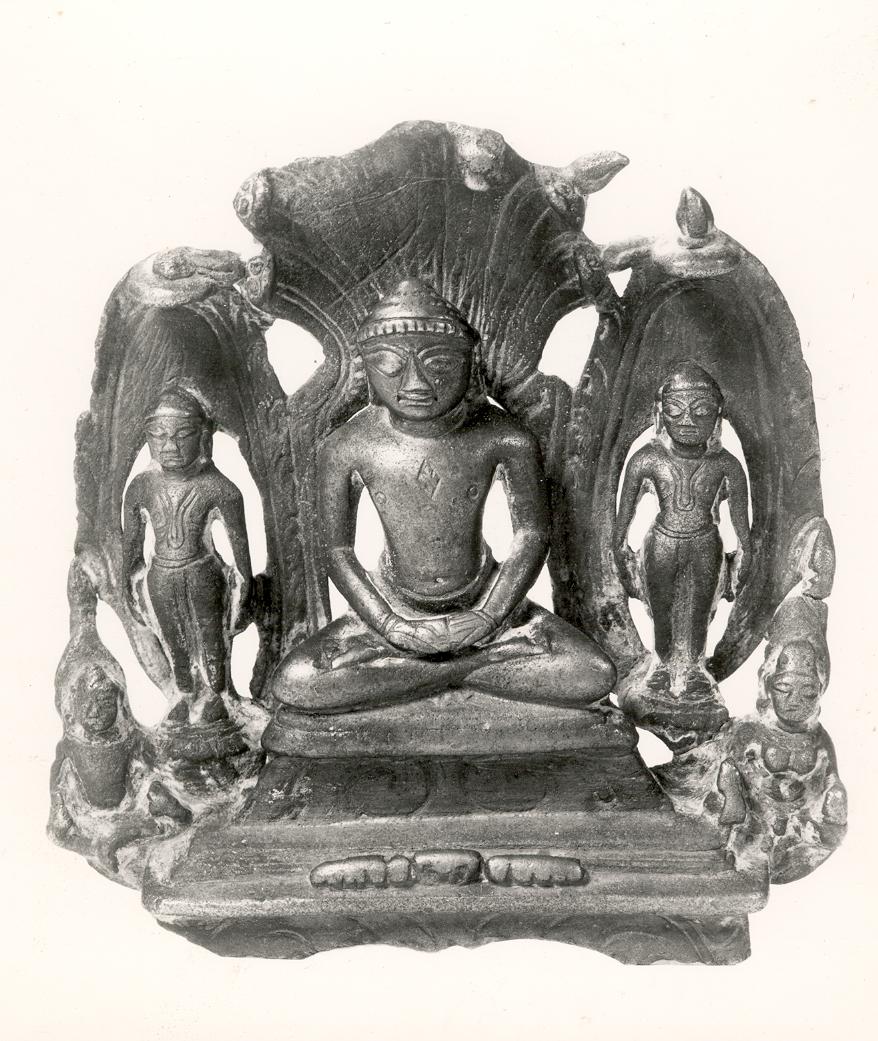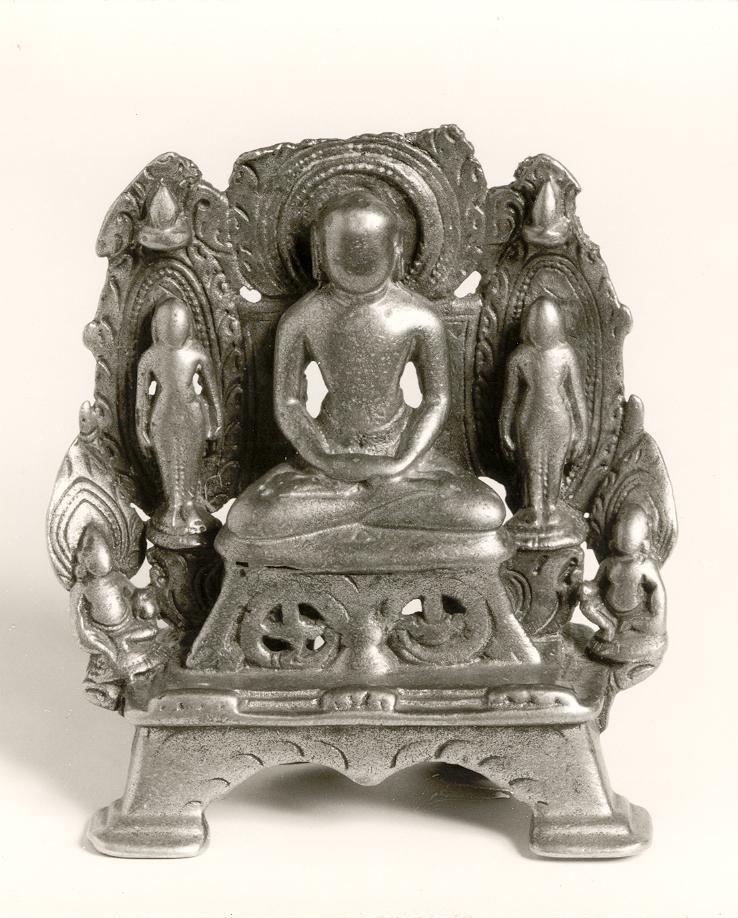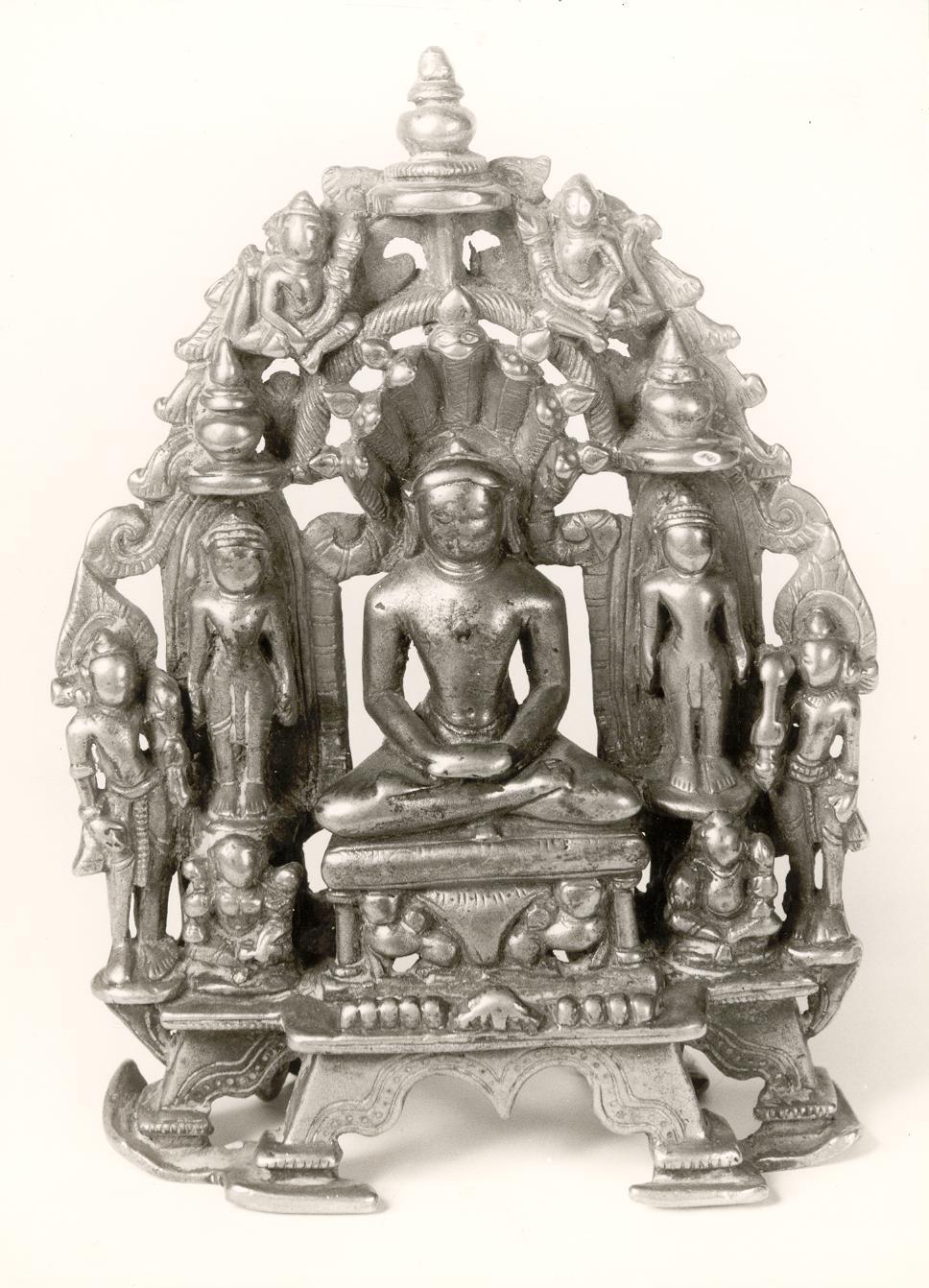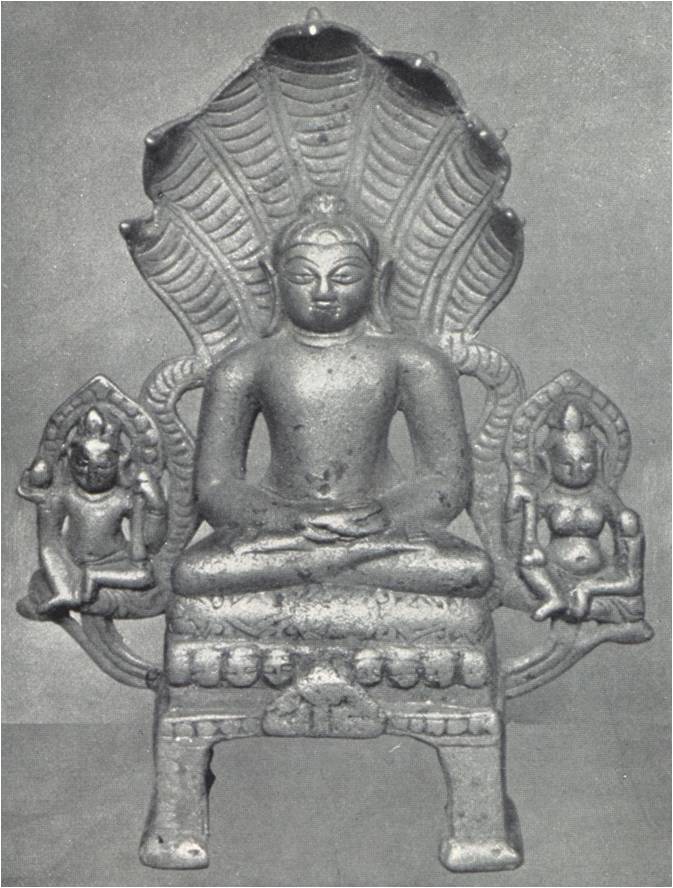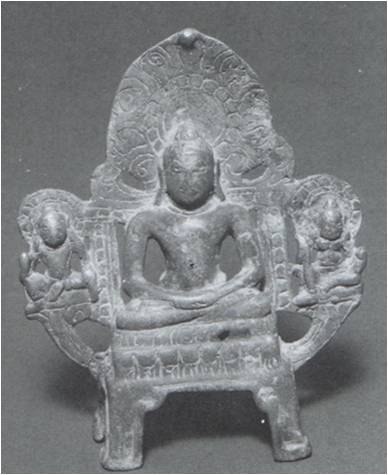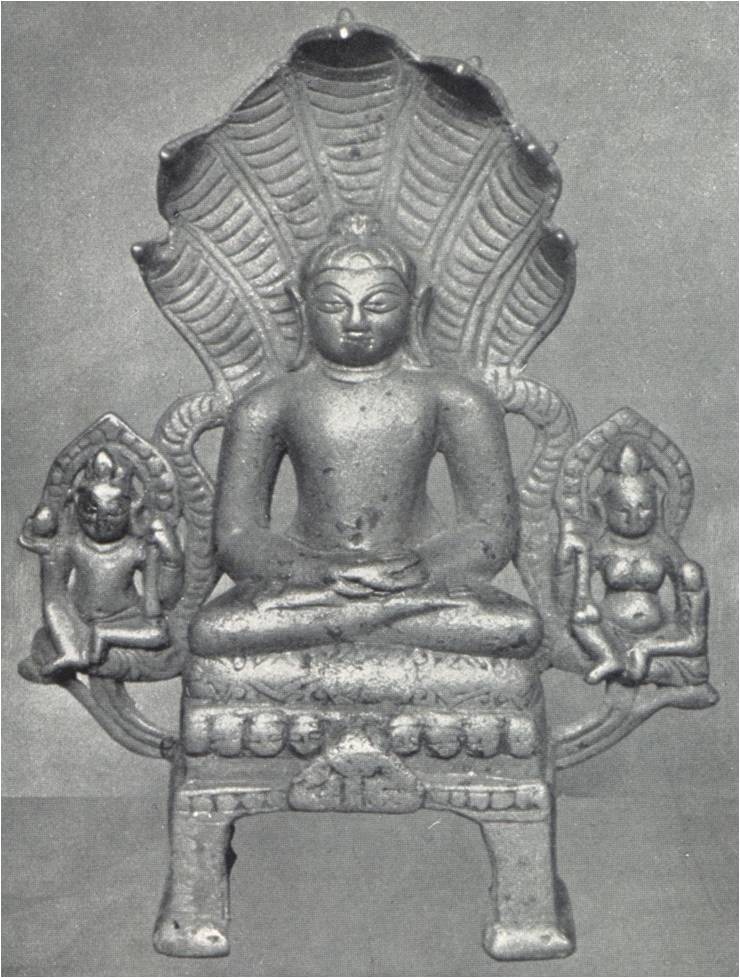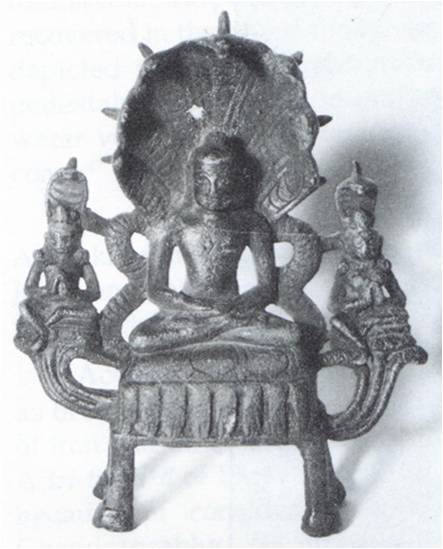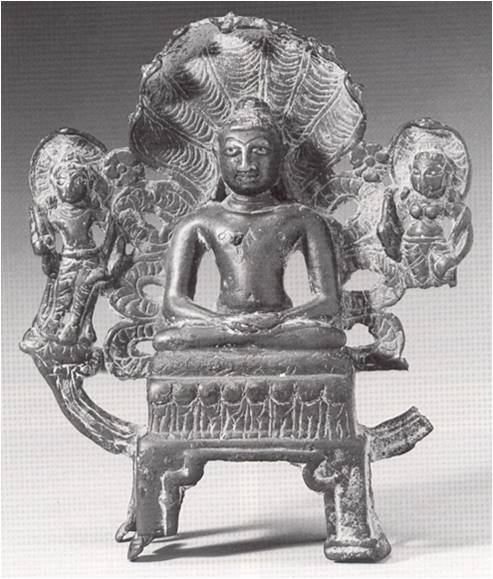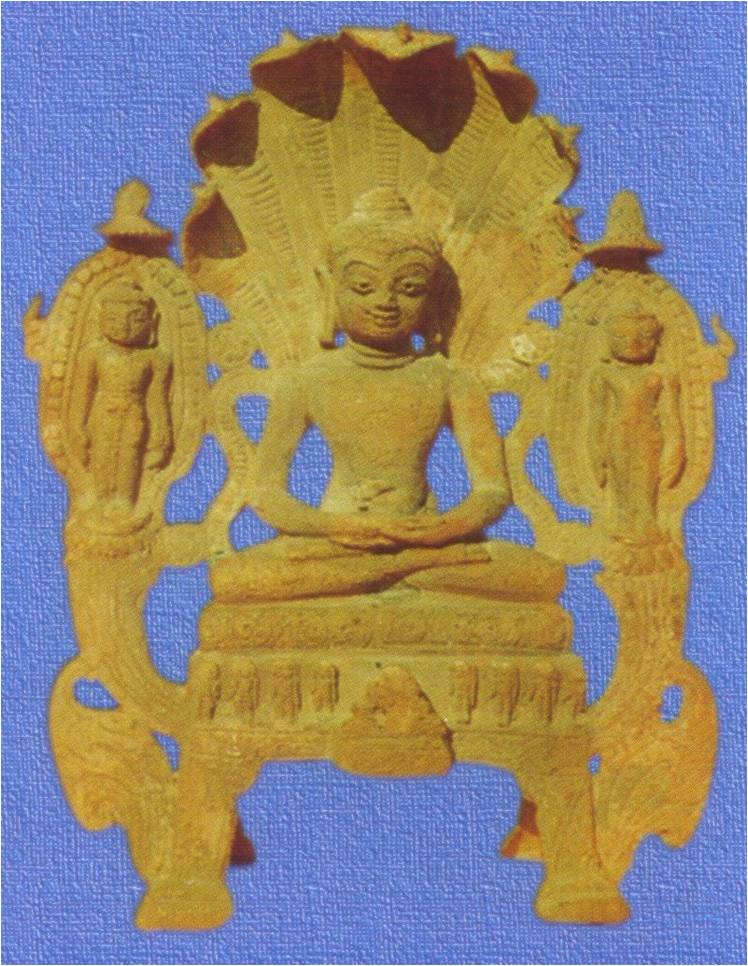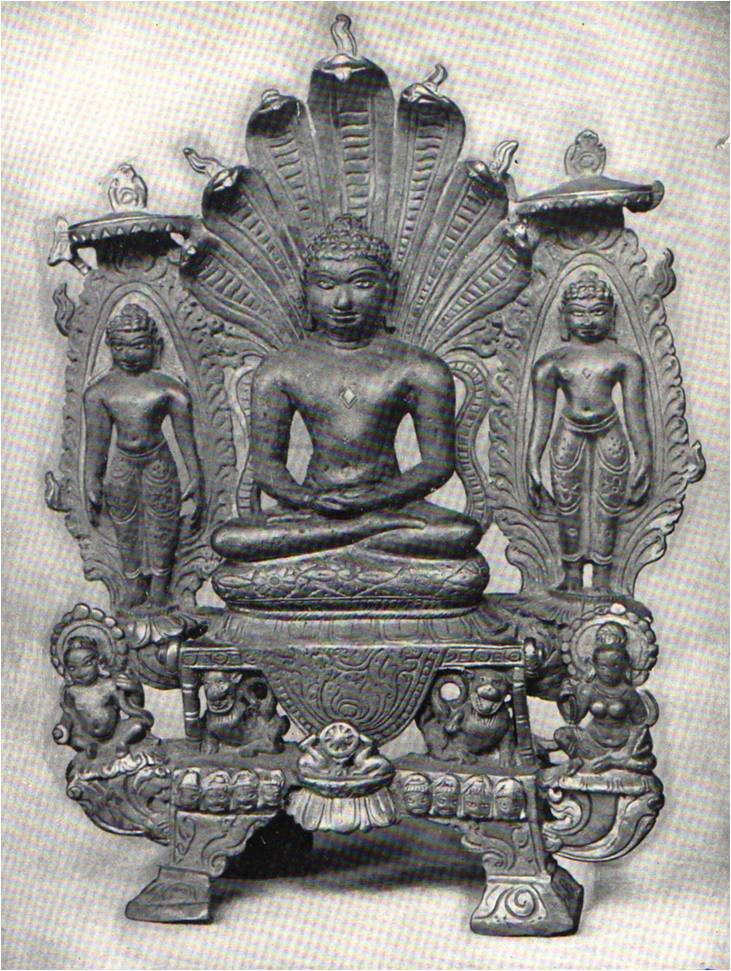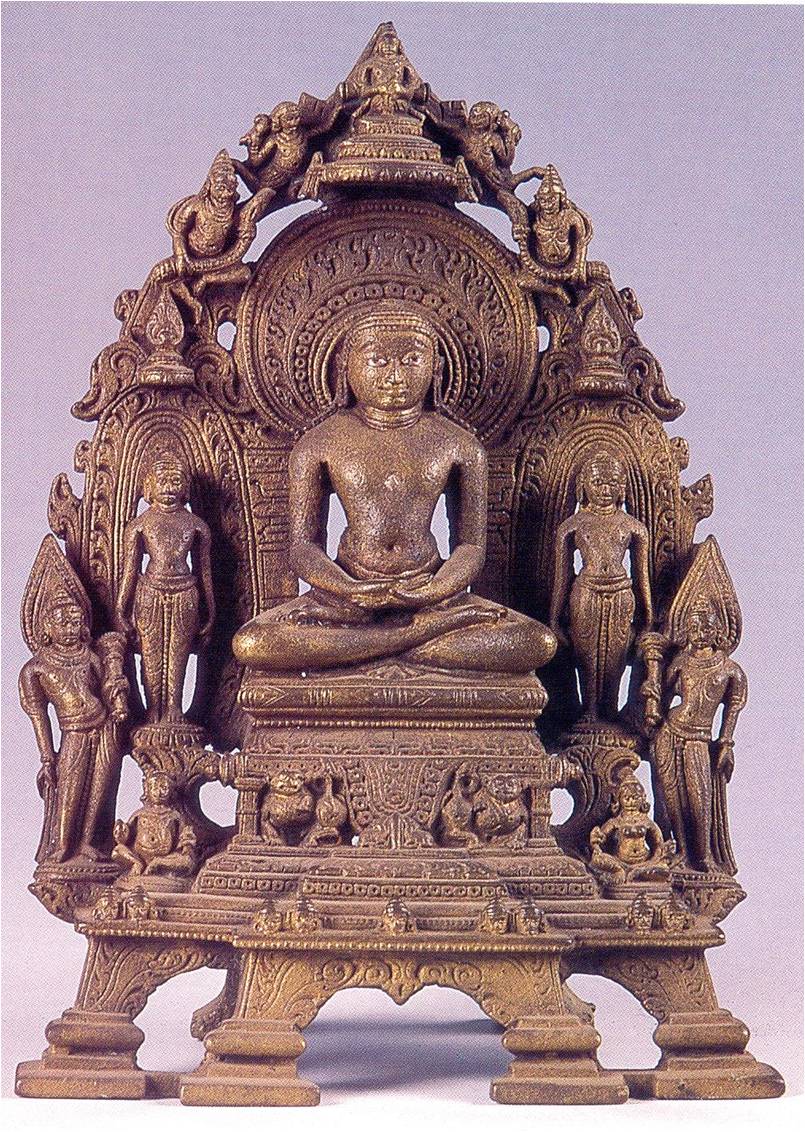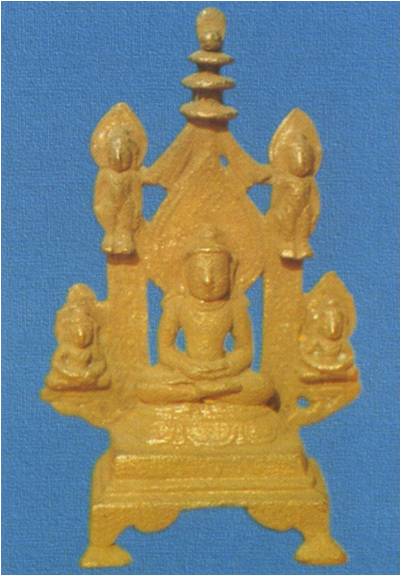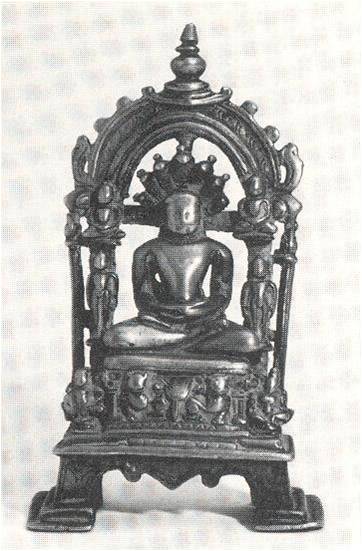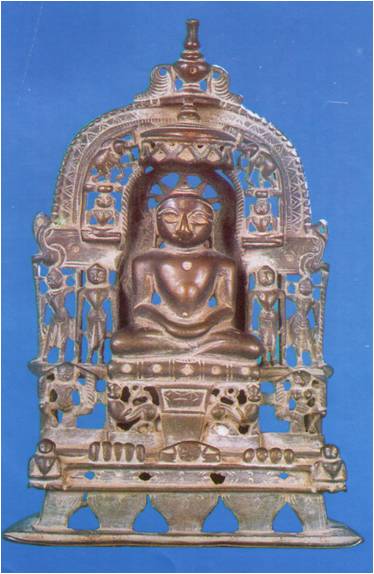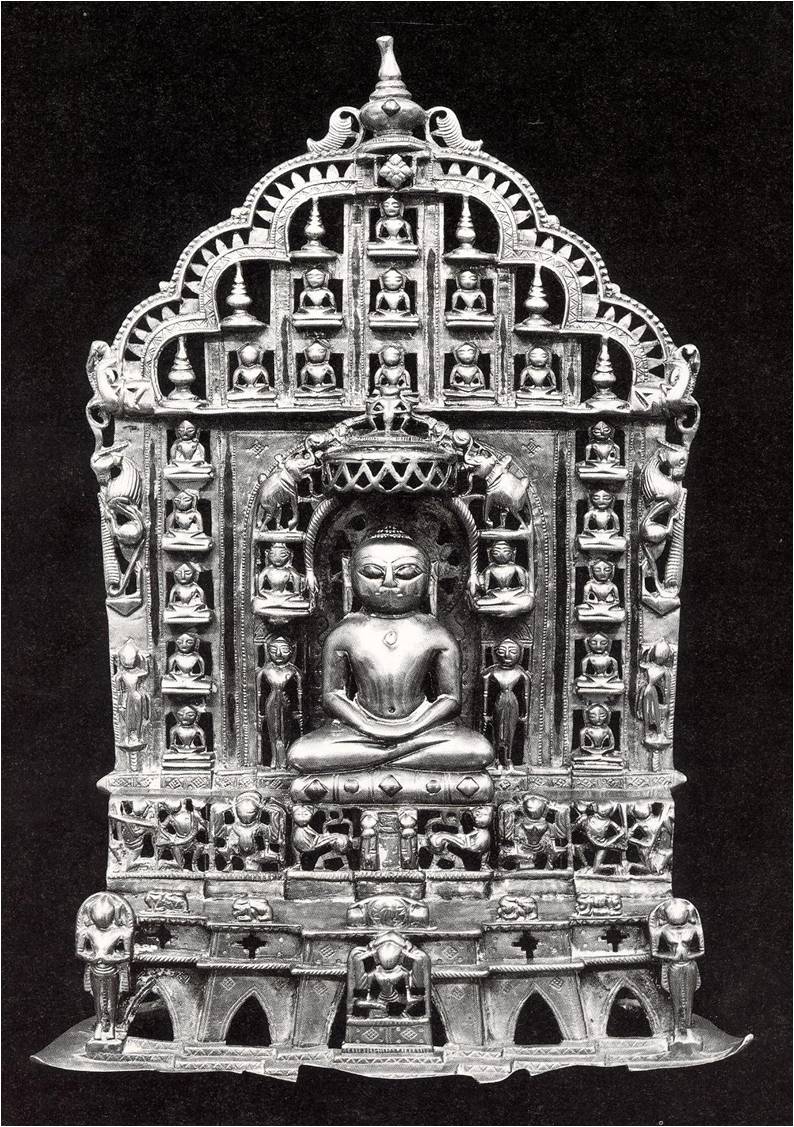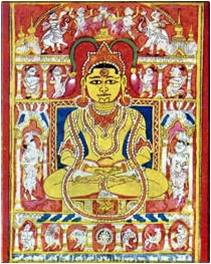This essay on the classification of Jaina bronze sculptures builds on an extensive study of Jaina bronzes which based on my MA Dissertation at the Freie Universitat Berlin on Jaina Bronzen aus Westindien (mainly Gujarat and Rajasthan), the results of which will be presented in greater detail in a forthcoming monograph. Pictures of many of the examined objects have already been published, e.g. by U. P. Shah, D. Handa etc. [1], and are well known, but a thorough investigation of the stylistic and iconographic correlations has heretofore been neglected. One of the challenges to classification has been that potentially key artefacts are held in private collections and are unknown, even among experts.
The iconographical arrangement of Jaina bronze sculptures became very schematic over the centuries and permits a classification into different categories. The categorization of Jaina bronze sculptures is very complex, so only some selected aspects can be presented here. To begin with, the stylistic and iconographic evolution of Jaina bronze sculptures can be divided into three main types which overlap chronologically.
- Early type (c. 2nd - 8th century CE)
- Advanced type (c. 6th - 13th century CE)
- Classical form (c. 6th - 10th century CE)
- Transitional form (c. 10th - 13th century CE)
- Late type (c. 13th - 19th century CE)
The bronze sculptures of every type can be subdivided into different categories on the basis of stylistic and iconographical features. Since the portrayals of Tīrthaṅkaras remained unvaried in terms of iconography, classification relies on the analysis of both the number and function of the attendant figures and the decorative ornaments.
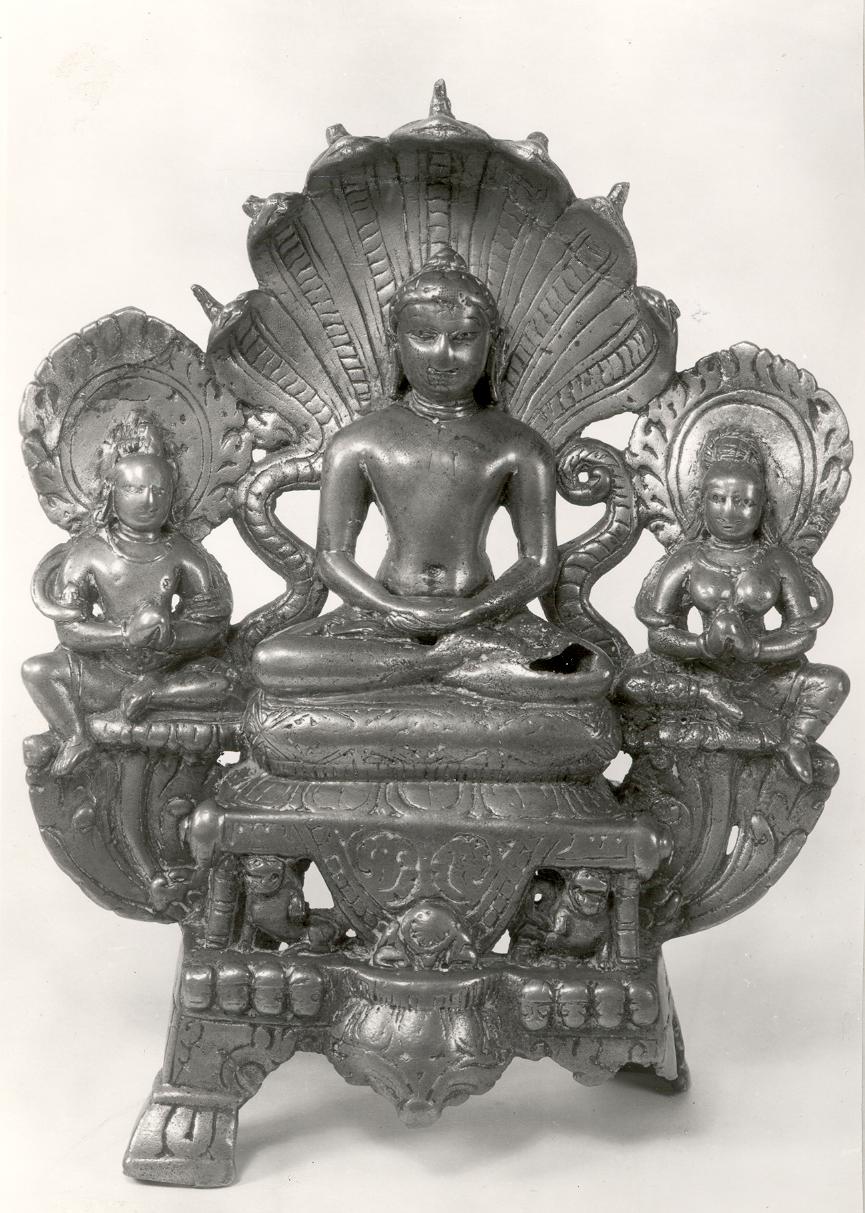 |
Figure 1. Pārśvanātha attended by a yakṣa couple (triad). Gujarat, c. 8th century CE, brass. National Museums Berlin, Asian Art Museum (Inv.-No. I 10145). |
1. Bronze sculptures of the early type
The earliest preserved Jaina bronze sculptures originate from probably the 2nd century CE and portray a standing Tīrthaṅkara with no attendant figures. Among these early sculptures are identifiable depictions of Pārśva (adorned by a serpent canopy) and Ṛṣabha (wearing long hair strands) as well as images of unidentifiable Tīrthaṅkaras with no iconographic features. The early tradition of portraits of a single Jina standing in kāyotsarga continued at least until c. 8th century CE but is still evident in a modified manner in the later tradition of Jaina bronzes. So in the proposed classification, depictions of standing Tīrthaṅkaras without attending figures are considered as a separate type. The number of the preserved bronzes of that type, including the Chausa hoard in particular, is small compared to the later types of bronzes.
2. Bronzes of the advanced type (classical form)
At least since the beginning of the 5th century CE a variety of images depicting sitting and standing Tīrthaṅkaras framed by a wide range of iconographical elements and attending figures appears. The origin of that development is unclear due to the lack of preserved objects from the phase of formation. The earliest sculptures of that type are from the Ākoṭā hoard [2] where the iconography is advanced, and includes not only the addition of attending figures like yakṣas, cāmaradharas or nāgas but also the depiction of iconographic features like dharmacakra, lion throne, etc. The adoption of Buddhist imagery, e.g. the dharmacakra flanked by gazelles, and the apparent resemblance of the Jina's face to the faces of Buddhist sculptures leads to the assumption that sculptures from both Buddhist and Jaina contexts were manufactured by the same artists. So the tradition of the multiple Jina image, e.g. the tri-tīrthika (composition of a seated Jina with two standing Jinas on either side) or pañca-tīrthika (composition of a seated Jina surrounded by four attendant Jinas), may be linked to earlier Buddhist triads (i.e. a Buddha attended by two Bodhisattvas).
Bronze sculptures of that type can be divided into Pārśva- and Non-Pārśva images. Images of Jina Pārśvanātha are characterized by the serpent canopy above the Jina's head (Fig. 1 and 2), while images of a Non-Pārśva depict a bhāmaṇḍala (halo) instead (Fig. 3). Both classes can be subdivided into different categories according to the number and function of the attendant figures."Slotfiller-analysis" allows a classification of the sculptures on the basis of the alternate attendant igures. This iconographical method, which was introduced by K. Bruhn [3], is predicated on the assumption that within the pictorial "program" a special type of figure ("slotiller") occupies a defined place ("slot").
In respect to the number of the depicted Tīrthaṅkaras, three categories can be distinguished:
- triad, i.e. a Jina flanked by two variable attendant figures (e.g. Kubera and Ambikā) (Fig.1),
- tri-tīrthika, i.e. a Jina flanked by two standing Tīrthaṅkaras and optional more attendant figures (Fig. 2 and 3),
- pañca-tīrthika, i.e. a Jina attendant by four standing and sitting Tīrthaṅkaras and optional further attendant figures.
An examination of the different categories leads to the conjecture that the development of the iconographical repertoire probably began by adding a yakṣa couple to a main icon. In a second step the attendant yakṣas were replaced by a nāga couple, cāmaradharas etc. or attendant Tīrthaṅkaras, but added again as minor attendant figures beneath the main icon.
At the beginning of the 8th century the pañca-tīrthika type was added to the triads and tri-tīrthikas. The development of the pañca-tīrthika type can be studied by examining the sculptures from the Hansi hoard. [4] Maybe a perceived need of differentiation of the Jaina community from the Buddhist community caused the displacement of the triad (which is also characteristic of Buddhist bronzes) with the pentad. Some bronzes from the Hansi hoard picture a couple of sitting Tīrthaṅkaras beneath the main icon and the attendant Jinas instead of the yakṣa couple. [5] The addition of a secondary Jina couple changes the appearance of the bronzes sculptures from a horizontal arrangement into a more vertical and stacked figurative shape. The stacked attendant figures frame the main icon, and this led to the development of a parikara, a decorated arch which is adorned with attending figures or varied ornament.
3. Bronzes of the advanced type (transitional form)
Bronze sculptures of the transitional type still belong to the advanced type. The naturalistically depicted figures and ornaments of the advanced type stand in sharp contrast to the geometrical style of the late bronze sculptures. However, the evolution of a parikara framing the main icon and the change of some iconographical attributes constitute a significant difference to the earlier bronzes of the advanced type. So the number of grahas (planet deities) are changed from eight (aṣṭagraha) to nine (navagraha), the yakṣa couple Kubera and Ambikā is replaced by Gomukha and Cakreśvarī, and images of the pañca-tīrthika style predominate.
The evolution of the parikara is based on the change to a more vertical arrangement of the composition as a result of the development of the panca-tīrthika and caturviṃśatipaṭṭa images (Fig. 5) and the addition of an iconographical repertoire on the top of the bronzes (Fig. 4), depicting elephants, flying garland bearers and musicians, etc., which belong to the aṣṭa-prātihāryas, or the "eight miraculous phenomena". According to some Jaina texts, e.g. Āśādhara's 13th-century Pratiṣṭhā-sāroddhāra (1.61-62) [6], a Jina should be accompanied by eight miraculous phenomena which are figurative, depicted generally above the Jina's head (cf. Fig. 5 and 6). The origin of the aṣṭa-pratihāryas is ambiguous. It may be because the list of these eight elements was codified after they became prominent as iconographical elements.
4. Bronzes of the late type
From about the 14th century the naturalistically depicted figures of the advanced type were replaced by an abstract geometrical imagery. The arrangement of the figures and ornaments became increasingly systematic and uniform. The bronze sculptures of the late type fall into two main categories, viz. a pañca-tīrthika form (Fig. 6) and a caturviṃśatipaṭṭa form (Fig. 7). The attendant figures as well as the iconographical features are depicted in a reduced and emblematical manner, e.g. the grahas are not identifiable but depicted as single knobs or bulge beneath the throne of the main icon. Also the attendant figures, cf. the cāmaradharas, are only identifiable by means of their place ("slot") inside the assembly.
The caturviṃśatipaṭṭa bronzes include depictions of all 24 Tīrthaṅkaras, most of them geometrically arranged around the main icon. The interior zone framing the main icon corresponds approximately to the assembly of the pañca-tīrthika sculptures. So the caturviṃśatipaṭṭa bronzes may be considered as a kind of enlarged version of the pañca-tīrthika bronzes.
Finally it must be stated that an exhaustive examination of the bronze sculptures of the late type is currently problematic. The analysis of the evolution of that type requires the examination of the largely unpublished bronzes of the Gogha hoard. [7] The few published objects of that hoard lead to the conjecture that the sculptures originate from the transitional period and later, and could, therefore, illustrate the evolution of the late type.
All photographs (excepting appendix) © National Museums Berlin, Prussian Cultural Foundation, Asian Art Museum, Art Collection South-, Southeast- and Central Asian Art.
Appendix
I. Pārśva- and Non-Pārśva images
Images of Pārśva are identifiable by a seven-headed Serpent-Canopy. This iconographical attribute defines the appearance of that images and classifies an own type of Jina depiction ("Pārśva") while the remaining twenty-three Tīrthaṅkaras (with the exception of Ṛṣabha) which are not distinguishable by iconographic features forming a combining type ("Non- Pārśva").
II. Variable attendant figures
a) seated attendant figures:
b) standing attendant figures: According to Klaus Bruhn the slotfiller-analysis allow a classification of sculptures on the basis of alternate Attendant-Figures. Within the pictorial program a special figure type ("slotfiller") occupies a defined place ("slot"). "We describe each variety as a system (grid) of different slots (Stellen, places) where each slot admits of different fillers (Stellenbesetzer, occupants). Images belonging to the same variety (to the same slot-filler-system) normally show some slots where the fillers differ in one way or another. The relative proportions within one and the same slot-system (“grid”) are nevertheless largely similar, and fillers appearing in one and the same slot are usually similar in character. Also, one and the same filler will normally appear in one and the same slot" (Klaus Bruhn, 'The Identification of Jina Images'. Berliner Indologische Sttudien 1, 1985: 151).
III. Evolution of pañca-tīrthika form from triad/tri-tīrthika form
a) Variable standing attendant figures:
b) Evolution of pañca-tīrthika form
IV. Development of the parikara (arch):
a) Extension of the figurative program above the main icon:
b) Developing of the framing arch:
c) Evolution of the framing arch:
V. Pañca-tīrthika form and caturviṃśatipaṭṭa form
The main icon of the Caturviṃśatipaṭṭa form is framed by an arch which is comosed by the same figurative program than the parikara of Pañca-tīrthika form. So, in some degree, the Caturviṃśatipaṭṭa form can be seen as an enlarged variant of Pañca-tīrthika form.
VI. Pañca-tīrthika form in miniature painting
The figurative program of Pañca-tīrthika form (bronze and stone sculpture), containing a main icon flanked by two standing and seated Jinas, a couple of elephants above, garland-bearers etc., has been adopted by miniature paintings since c. 14th century CE.
Umakant P. Shah: Akota Bronzes, Bombay: Department of Archaeology, Government of Bombay, 1959; Umakant P. Shah: Bronze Hoard from Vasantagadh. Lalit Kalā, Nos. 1-2 (1955-56), pp. 55-65; Devendra Handa, Jaina Bronzes from Hansi, Shimla and New Delhi: Indian Institute of Advanced Study 2002.
Devendra Handa, Jaina Bronzes from Hansi, Shimla and New Delhi: Indian Institute of Advanced Study 2002.
Hampa Nagarajaiah, Morphology of Jaina Architecture, Shravana-belgola: National Institute of Prakrit Studies and Research, 2007, p. 2. Other text sources of the aṣṭa-prātihāryas (or aṣṭa-mahā-prātihāryas) are mentioned by U.P. Shah in his paper on the 'Evolution of Jaina Iconography and Symbolism' (in: U.P. Shah / M.A. Dhaky (eds.), Aspects of Jaina Art and Architecture, Ahmedabad: Gujarat State committee for the Celebration of the 2500th Anniversary of Bhagavān Mahāvīra Nirvāṇa, pp. 49-74.
The hoard includes 275 bronze sculptures and was briefly presented in Indian Archaeology 1961-62: 97, plate CXLI/CXLII and Asian Perspectives Vol. VII, Summer-Winter 1963, Nos. 1-2: 34, Pl. IVa. A few selected sculptures were discussed in a short essay by Lalit Kumar ('Some Jaina Bronzes from an Unpublished Ghogha Hoard'. Nirgranth 2, 1996). Finally, a single bronze from that hoard is mentioned in the catalogue of the Lalbhai Dalpatbhai Museum in Ahmedabad where the objects are assumed to be held.
 Dr. Patrick Krueger
Dr. Patrick Krueger
